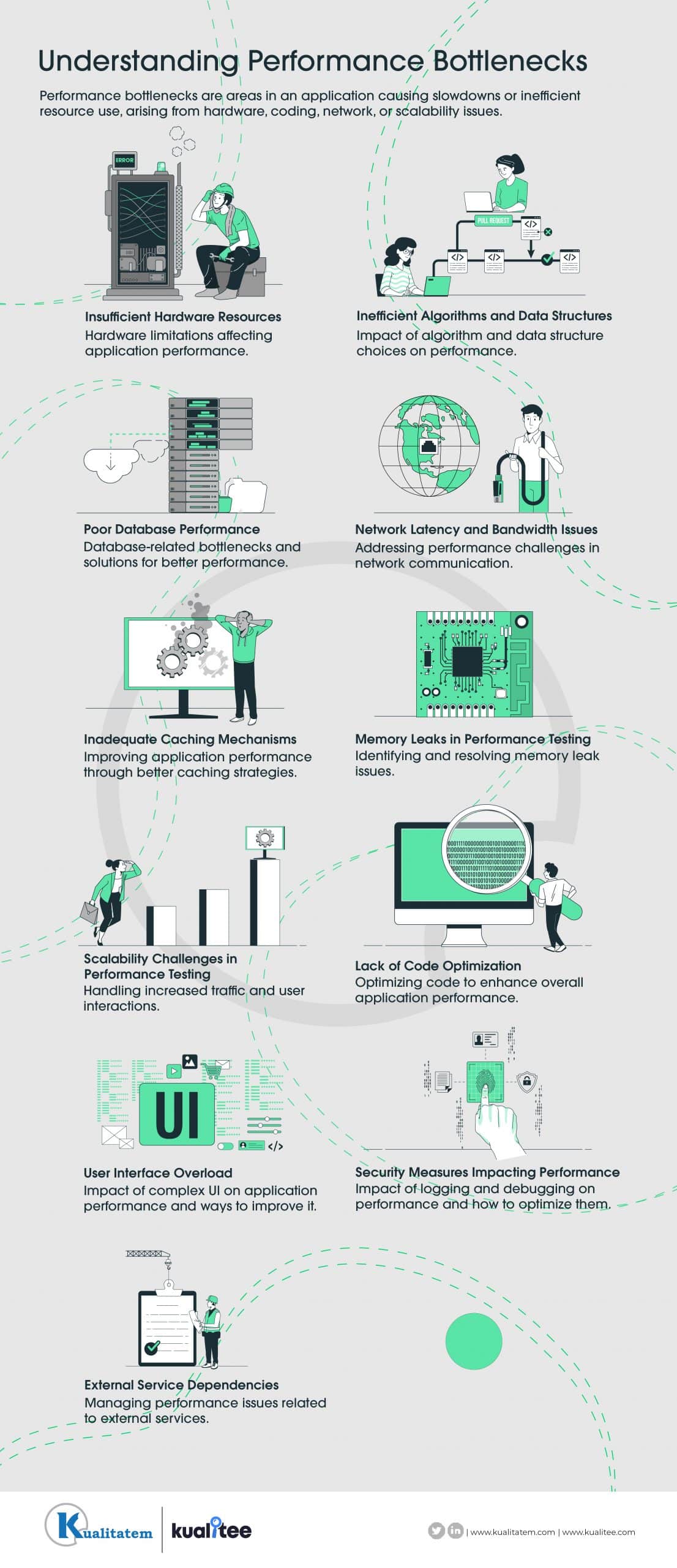Common Bottlenecks in Applications During Performance Testing

- July 14, 2023
- admin
Applications are incredibly important in numerous aspects of our life. Users expect fast speeds whether they are using desktop software, a mobile app, or both. However, there are times when programs encounter performance bottlenecks that hinder their optimal functioning. These can be improved with the help of testing.
We will explore common bottlenecks in this article, along with practical solutions.
Understanding Performance Bottlenecks
It refers to specific areas within an program that cause slowdowns or inefficient resource utilization. These bottlenecks stem from various sources, including hardware limitations, poor coding practices, network issues, and scalability challenges.
To optimize program speed, it is crucial to identify and address these bottlenecks systematically.
Insufficient Hardware Resources
Inadequate hardware resources significantly impact performance. Insufficient RAM, slow processors, or limited storage capacity lead to sluggish response times and an overall poor user experience. To address this bottleneck, it is necessary to evaluate the application’s hardware requirements and ensure that the infrastructure meets the demands of the software.
Inefficient Algorithms and Data Structures
Performance can be significantly impacted by the selection of algorithms and data structures. Inefficient algorithms or inappropriate data structures results in slow execution, high memory usage, and increased CPU load. By analyzing and optimizing algorithms and data structures, developers enhance program efficiency and responsiveness.
Poor Database Performance
Programs that rely on databases for data storage and retrieval encounter bottlenecks due to poor database design or inefficient queries. Slow database queries, a lack of proper indexing, or excessive data processing causes delays and impact the overall speed. Optimizing database schemas, improving query efficiency, and implementing caching mechanisms can help address these bottlenecks.
Network Latency and Bandwidth Issues during Performance Testing
In a connected world, network latency and limited bandwidth causes issues , especially for cloud-based or distributed systems. Delays in data transmission, high latency, or limited bandwidth results in slow response times and a poor user experience. Mitigating these issues requires optimizing network communication, minimizing unnecessary data transfers, and implementing effective caching strategies.
Inadequate Caching Mechanisms
By keeping frequently visited data closer to the application, caching is a potent strategy for enhancing speed. Inadequate or improper caching mechanisms lead to increased load on databases and slower response times. Implementing efficient caching strategies, such as content caching, query caching, or using in-memory data stores, significantly boosts performance.
Lack of Code Optimization
Writing clean and optimized code is crucial for achieving optimal performance. Inefficient code, such as excessive loops, redundant computations, or improper memory management, can strain system resources and result in issues. Developers should focus on optimizing code, minimizing resource usage, and following best practices to improve overall speed.
Memory Leaks in Performance Testing
When a program neglects to free up memory that is no longer required, memory leaks happen, slowly depleting system resources. Crashes, slower response times, and greater memory utilization are all consequences of memory leaks. Implementing proper memory management techniques, such as garbage collection or manual memory deallocation, helps mitigate memory leaks and provide overall improvement.
Excessive Logging and Debugging
While logging and debugging are essential for maintenance, excessive logging or inefficient debugging practices impacts performance. Writing an excessive number of logs or enabling verbose debugging can cause unnecessary overhead and slow down the application. Developers should ensure that logging and debugging practices are optimized and used judiciously to minimize their impact on speed.
Security Measures
Implementing robust security measures is crucial for protecting programs and user data. However, certain security measures, such as encryption or intensive authentication processes, can introduce performance overhead. Striking a balance between security and speed is important, and developers should employ efficient security practices without compromising the responsiveness.
Scalability Challenges
As the user base grows, it must be able to handle increased traffic and user interactions without sacrificing performance. Scalability challenges, such as poor load balancing, inadequate resource provisioning, or a lack of horizontal scaling, leads to bottlenecks. Designing applications with scalability in mind, employing load balancing techniques, and utilizing cloud-based infrastructure addresses these challenges.
User Interface Overload
A cluttered and complex user interface overwhelms users and impact performance. Excessive graphical elements, unnecessary animations, or inefficient rendering slow downs the responsiveness. Simplifying the user interface, optimizing graphics and animations, and utilizing responsive design principles improves the overall user experience and speed.
External Service Dependencies
Applications often rely on external services, such as APIs or third-party integrations, to provide additional functionality. Performance bottlenecks arise if these services experience downtime, latency issues, or rate limiting. Implementing proper error handling, fallback mechanisms, and efficient caching of external service responses mitigate these bottlenecks and ensure a smoother user experience.
Why Look For Common Bottlenecks?
In conclusion, bottlenecks significantly impact speed and user satisfaction. Identifying and addressing these bottlenecks requires a systematic approach, involving hardware evaluation, code optimization, network optimization, database optimization, and scalability considerations. Developers can give users a smooth and effective experience by being proactive in optimizing the speed of their applications with the help of performance testing services.












